Abstract
Socio-economic instability, the clash and interpenetration of different cultures affect all members of society but most of all young people, whose moral norms, valuable orientations, ideals, and life goals are in the process of formation and reassessment. The purpose of this study was to assess the impact of socio-demographic factors (gender, age) and ethno-cultural determinants (ethnic, confessional and socio-cultural affiliation) on the formation of the morality of modern students. The following methods were used in order to achieve this goal: a comprehensive analysis of domestic and foreign psychological and pedagogical scientific literature as well as a statistical analysis of the data obtained through psychological testing using the "Personal Moral Self-determination" scale. A total of 490 young people of different ethnicities participated in the research. The findings revealed that ideas about morality and morals, moral strategies and moral orientations of students ' personality are largely determined by their belonging to a specific ethnic group, religious affiliation, gender and age.
Keywords: Morality, morals, socialization, student youth, socio-demographic factors, ethno-cultural determinants
Introduction
The issue of spiritual and moral education of young people is becoming particularly relevant in the current situation of socio-economic development and global digitalization of society. Kupreichenko and Vorobiova (2013) note that currently there is a formation of such a branch of science as the psychology of morality, the subject of which “are psychological phenomena and laws associated with the formation and functioning of an integral system of views on social life, the essence of a person and his being, evaluated in the categories of good and evil” (p. 19). Analyzing the moral and psychological problems of current research, the following areas can be distinguished.
The most developed direction is the research on the stage of moral development, the level of development of moral judgments and moral consciousness. Potanina and Gusev (2018) propose to consider a pragmatic/non-pragmatic vision of the world as an indicator of moral development, that is, the ability to relate the properties of objects and phenomena from the point of view of moral values. Molchanov et al. (2019) established differences in the level of moral judgments of adolescents depending on the type of psychological well-being. If a balanced type of psychological well-being is characterized by a high level of moral judgment and the efficiency of processing social information, then the ego-centered type reveals low-level moral judgment, self-orientation and self-interest, low effectiveness of cognitive methods of processing social information with severity of symptoms of Internet addiction. Molchanov et al. (2018) revealed the relationship between cognitive ways of processing social information of the Internet network and the features of moral consciousness and ideas about moral regulation, responsibility and moral sensitivity. Preference for moral judgments of the post-conventional level, willingness to recognize moral responsibility in a situation of violation of moral norm, sensitivity to the moral content of communication and interpersonal interaction are observed in adolescents with high efficiency of cognitive processing of information. On the contrary, the high significance of moral judgments of the preconventional level, the heterogeneity of moral consciousness, and the low readiness to recognize moral responsibility are combined with low efficiency of cognitive processing of information.
Medvedeva et al. (2019) analyze gender differences in moral decision-making in their works. Crocetti et al. (2019) found that level of morality and competence increases among girls, while indicators decrease in all aspects among boys.
A number of works are devoted to the research of the fundamental moral properties of the personality. Thus, Shadrikov (2018) developed an intra individual structure of conscience, which determines a personal moral behavior. “Conscience is both a mechanism for motivating behavior and a mechanism for evaluating behavior" (Shadrikov, 2018, p. 11). The highest moral qualities include virtue (benevolence), free will, love for others, empathy and reflexivity. Kindness as a socio-psychological category was the subject of analysis in the study of Cotney and Banerjee (2017). As a result of the organization of six focus groups, a multifaceted understanding of kindness by adolescents was revealed, a connection was found between the manifestation of kindness and psychological well-being.
Kupreichenko and Vorobiova (2013) developed a theoretical model of the content and structure of moral self-determination as a complex phenomenon of moral consciousness, created methodological tools. The empirical study revealed socio-demographic (gender, age, family status, different type of employment) and personal factors (factors according to Kettell (cited in Kupreichenko and Vorobiova (2013)), the level of self-regulation, the level of emotional intelligence) of moral self-determination of various groups of youth.
There are a number of studies of the moral determination of professional activity, economic and social activity of the subject. Veselova and Korzhova (2020) propose to distinguish two levels of professional interaction in the activity of a practical psychologist: role and personality When interacting professionally with a client at the role level, a school psychologist does not need any deep personal involvement, external motives of moral regulation (knowledge of the ethical code and fear of administrative sanctions) are psychological mechanisms for observing ethical standards. To fulfill professional duties at the personal level, it is necessary to have an internal motivation for moral behavior (conscience, maturity, positive life philosophy). Vorobiova (2013) conducted a comparative study of the moral self-determination of future specialists in advertising, psychology, economics, management. Zhuravlev and Kupreichenko (2007) study the moral and psychological regulation of economic activity. Akimova and Galstyan (2019) using cluster analysis identified the types of students who differ in strategies of social interaction. Such moral standards as trust, honesty and solidarity are considered as factors of social activity of student youth.
A number of works are devoted to the analysis of methods of influencing the moral consciousness and behavior of modern youth. Lopatukhina and Rynkevich (2016) propose to make changes to the higher education system by strengthening and emphasizing in the educational process the student education system, carried out on the basis of national values and traditions. The authors propose a content three-factor pedagogical model of educating a person of culture: 1) a spiritual person; 2) a moral person; 3) an intellectual person. According to the results of the study by Kislyakov et al. (2020), the dominant moral grounds and norms of prosocial behavior of young people are norms of care, justice, and social responsibility. The researchers focus on the expediency of using situational modeling aimed at solving moral dilemmas and forming attitudes towards prosocial behavior within the framework of the implementation of the disciplines of the humanities cycle. Social psychology has accumulated experience in implementing programs of moral education and the development of moral consciousness through the involvement of children and youth in public work, volunteering and charity. The results of an empirical study, in which 180 employees aged 18 to 30 years of a large socially oriented enterprise of the Ural-Sinarsky pipe plant took part, indicate that charity work contributes to the formation of moral standards and qualities among young people, such as selflessness, responsiveness, civic identity (Popova & Popova, 2018).
Problem Statement
The strategy of the state youth policy of the Russian Federation, implemented until 2025, determines the social order of the higher education system for the formation of a harmonious, constantly improving, competitive person with a strong moral core. In order to implement this order, it is necessary to create conditions aimed at civil-patriotic and spiritual-moral education of student youth. The problem of spiritual and moral education of the younger generation raises the question of which determinants contribute to the formation of moral identity, humanistic worldview, a stable system of moral and civic values.
Research Questions
What socio-demographic and cultural factors influence the formation of ideas about morality and morals, moral strategies, and moral orientation of the personality of modern students?
Purpose of the Study
The purpose of this study was to assess the impact of socio-demographic factors (gender, age) and ethno-cultural determinants (ethnic, confessional and socio-cultural affiliation) on the formation of the morality of modern students. We assumed that socio-demographic (gender, age) and ethno-cultural factors (ethnic, confessional and socio-cultural affiliation) determine the peculiarities of ideas about morality and morals, moral strategies and moral orientations of students ' personality. The research objectives included:
4.1. to identify socio-demographic factors (gender, age) of the development of morality among modern students;
4.2. to establish the ethno-cultural determinants (ethnic, confessional and socio-cultural affiliation) that determine the development of the morality of student youth.
Research Methods
Research Design
The research design was quantitative in nature but was based in a thorough review and generalization of the content of psychological and pedagogical literature which allowed for relevant issues to be uncovered which drove this investigation. A previously developed psychological scale the “Personal Moral Self-determination" by Vorobieva and Kupreichenko (cited in Zhuravlev & Kupreichenko, 2007) was used as the primary data collecting instrument. Several statistical procedures were used to analyze the data to obtain the results that would answer the research questions.
Sample
490 students involving 126 young men and 364 young girls took part in this study. All respondents were informed about the study and agreed to participate. During the data collection process, the students were informed about the topic and that their participation was voluntary; the confidentiality of the research was emphasized and the researchers remained in the venue to answer any questions. For comparative analysis, the total sample was divided into age cohorts: youth (17-19 years old) – 214, and early adulthood (20-22 years old) – 276. By ethnicity, the study group included 248 Russians, 71 Kazakhs, 49 Turkmens, 37 representatives of the Caucasian peoples, 35 Tatars, 31 Mestizos and 19 representatives of other nationalities. According to the confessional affiliation in the study group, the most widely represented were Orthodox-205, Muslims-196, and Atheists-67. Depending on their social status, the subjects were divided into citizens of the Russian Federation (388 students) and migrants, mainly from neighboring countries (102 students).
Research Instrument
The "Personal Moral Self-determination" scale developed by Vorobieva and Kupreichenko (as cited in Zhuravlev & Kupreichenko, 2007), was used to determine the students’ perceptions about morality and morals, moral strategies and moral orientations. Subjects were asked to rate 87 statements on a 5-point scale. The scale contains three semantic blocks. The block "Ideas about morality, morals" contains the following characteristics: the origin of morality as phenomenon, the importance of morals, morality for society; absoluteness or relativity of morality; retribution for good and evil; perceptions of morality as strength or weakness of personality; and the nature of morality. The "Moral Strategies" block, presents parameters such as the mandatory or optional observance of moral standards; activity or passivity of moral behavior; and the reciprocity or non-reciprocity of moral conduct. The "Moral Orientations of Personality" block includes egocentric, group centric, humanistic and world creating orientation. Scores on each scale for each test subject are calculated according to the procedure key.
Data Analysis Procedures
The data analysis was carried out using comparative data analysis procedures such as the Kolmogorov-Smirnov One-sample Test, Student’s T -Test for Independent Samples, The Mann-Whitney U test, One-factor Analysis of Variance for Independent Samples, and the Kruskal-Wallis Test. Statistical data processing was carried out using the IBM statistical package SPSS Statistics 21.
Findings
Socio-demographic factors of the development of morality among modern students
The Mann-Whitney test identified significant differences in indicators such as the origin of morality between young men and young women (the value of U = 19254 at a significance level of p = 0.007), the importance of morals for society (U = 19137.5 at p = 0.005), the retribution for good and evil (U = 17786 at p < 0.001), the emotional component of the obligation to observe moral norms (U = 19009 p = 0.004), the cognitive component of the activity of moral behavior (U = 19779 at p = 0.02), the emotional component of the activity of moral behavior (U = 17553.5 at p < 0.001), the humanistic orientation (U = 17925.5 at p < 0.001), and the world-creating orientation (U = 19466 at p = 0.011). Figure 1 shows that the males of the sample largely developed an emotional component of moral behavior. Young women, on the other hand, differed from young men in higher values of the origin of morality, the importance of morals for society, the retribution for good and evil, the emotional component of the obligation to observe moral norms, the cognitive component of the activity of moral behavior, the humanistic orientation, and the world-creating orientation.
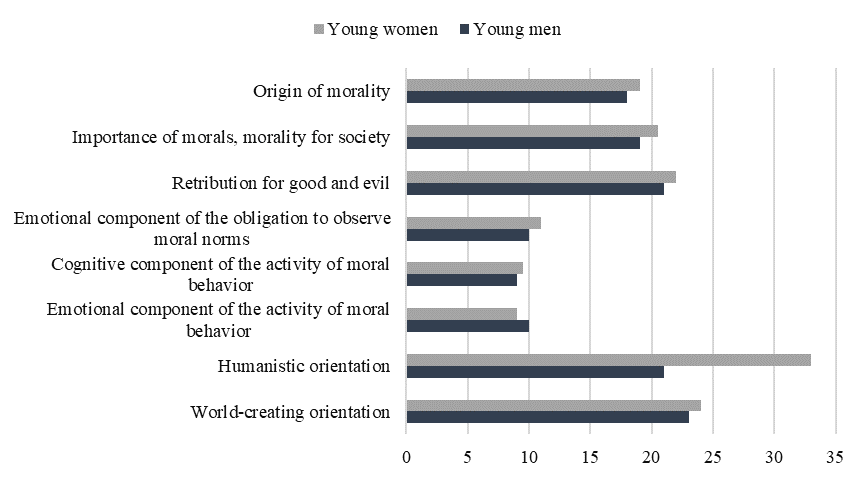
Depending on the age of the respondents, significant differences were detected for the following variables: the importance of morals for society (U = 25101 at p = 0.004), the retribution for good and evil (U = 23723.5 at p < 0.001), the idea of morality as the strength or weakness of the personality (U = 22112 at p < 0.001), the emotional component of the obligation to observe moral norms (U = 25138 at p = 0.004), the conative component of the activity of moral behavior (U = 24624 at p = 0.001), the group centric orientation (U = 25836 at p = 0.017),the humanistic orientation (U = 22777 at p < 0.001), and the world-creating orientation (U = 23165.5 at p < 0.001). Figure 2 shows that the youth exhibit higher values of the above components of morality compared to the early adulthood sample.
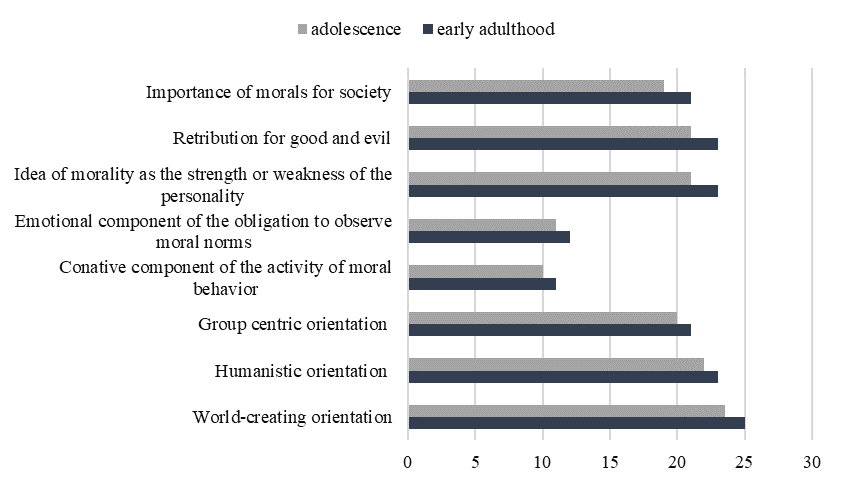
Thus, gender and age determine the peculiarities of the development of ideas about morality, moral strategies and moral orientations of the personality of modern students.
Ethno-cultural factors of moral development among modern students
The Kruskal-Wallis (H) uncovered significant differences in terms of morality depending on ethno-cultural background of the respondents: the importance of morality for society (H = 5.197 at p = 0.392), the retribution for good and evil (H =27.848 at p < 0.001), the idea of morality as the strength or weakness of the personality (H = 29.255 at p < 0.001), the nature of personal morality (H = 41.187 at p < 0.001), the emotional component of the activity of moral behavior (N = 27.84 at p < 0.001), the humanistic orientation (N = 27.939 at p < 0.001), and the world-creating orientation (N = 18.929 at p = 0.002). The analysis of the median values presented in Figure 3 showed that the Russians and the Mestizos recognize the high importance of the morality and morals for society. The peoples of the Caucasus and the Mestizos believe that the retribution for good and evil is in the nature of a direct correspondence i.e. the villain will sooner or later be punished. The representatives of the peoples of the Caucasus are characterized by a great confidence that the observance of moral norms is an indicator of the strength of the personality. The Russians, the Kazakhs and the peoples of the Caucasus are aware of their own responsibility for their moral appearance and ethical behavior. Tatars, more than representatives of other nationalities, adhere to the strategy of the activity in observing moral norms on an emotional level. The peoples of the Caucasus are more inclined to the humanistic orientation of the personality. The Mestizos are distinguished by a high commitment to the personality of a world-creating orientation.
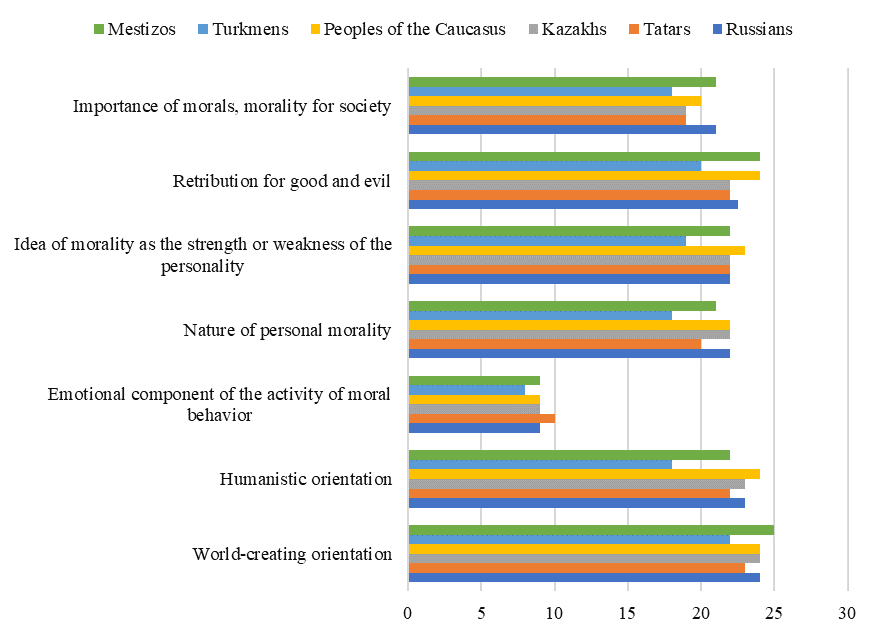
The Kruskal-Wallis procedure highlighted significant differences in the following scales of the “Personal Moral Self-determination” scale depending on the religion of students: the origin of morality (H = 27.718 at p < 0.001), the importance of morality for society (H = 19.476 at p < 0.001), the absoluteness / relativity of morality (H =12.81 at p = 0.002), the retribution for good and evil (H =17.014 at p < 0.001), the idea of morality as the strength or weakness of the personality (H = 11.859 at p = 0.003), the nature of personal morality (H = 16.571 at p < 0.001), and the emotional component of the activity of moral behavior (N = 10.303 at p = 0.006). Figure 4 shows that students who profess Orthodoxy and Islam have higher values on the “origin of morality” scale, i.e., they tend to think about the natural origin of morality. High indicators on the scale of “the importance of morality for society” mean that the Orthodox and the Atheists recognize the high importance of morality and morals for society. The Orthodox and the Muslims recognize the absoluteness of morality, while the Atheists consider the moral norms relative and dependent on the situation. The Orthodox students are distinguished by the highest indicators on the scale of “retribution for good and evil”, i.e., the villain will definitely be punished. The Orthodox, unlike the Muslims and the Atheists, recognize that the strength of the personality is manifested in the observance of moral norms. The Atheists are characterized by the presence of internal moral control of the personality, and an awareness of their responsibility for their own moral behavior. The Orthodox Christians are more likely to adhere to the strategy of activity in observing moral norms on an emotional level compared to the students of other faiths.
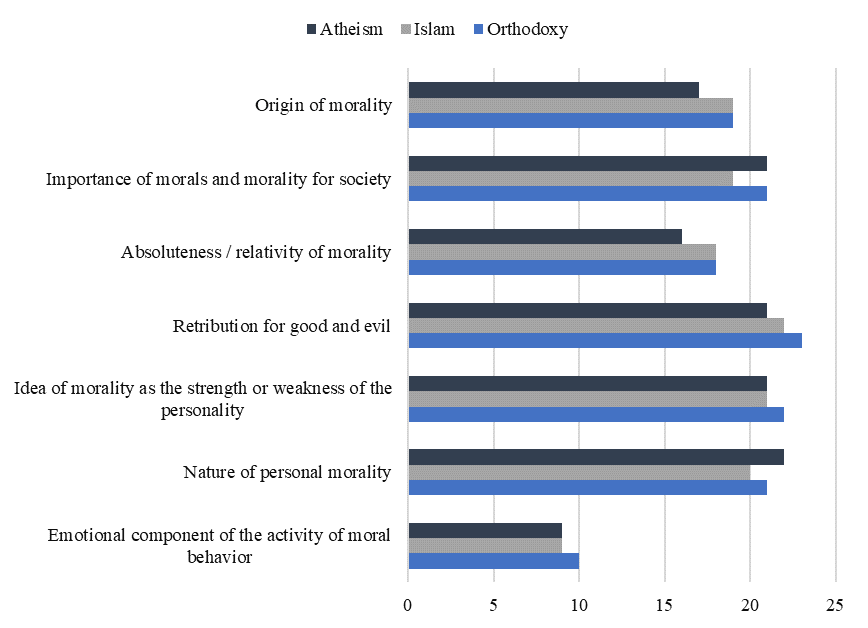
Currently, there are 2,230 foreign citizens studying at the Astrakhan State University from 50 countries. The Mann-Whitney test found significant differences between students who are citizens of the Russian Federation and foreign students in terms of such indicators such as the importance of morality for society (U = 13678.5 at p < 0.001), the retribution for good and evil (U = 14867.5 at p < 0.001), the idea of morality as the strength or weakness of the personality (U = 14872.5 at p < 0.001), the nature of personal morality (U = 14068 at p < 0.001), the emotional component of the obligation to observe moral norms (U = 16843 at p = 0.02), the emotional component of the activity of moral behavior (U = 14997.5 at p < 0.001), the humanistic orientation (U = 15089.5 at p < 0.001), and the world-creating orientation (U = 16423.5 at p = 0.008). Figure 5 clearly demonstrates that students from Russia are more inclined to recognize the high importance of morality and morals for society, to believe that moral actions are rewarded, and evil is punished, to believe that observance of moral norms is an indicator of a strong personality and that everyone is personally responsible for his moral appearance. They also tend to be more eager to necessarily and actively observe moral norms on an emotional level. They are more inclined to a humanistic and world-creating orientation of the personality.
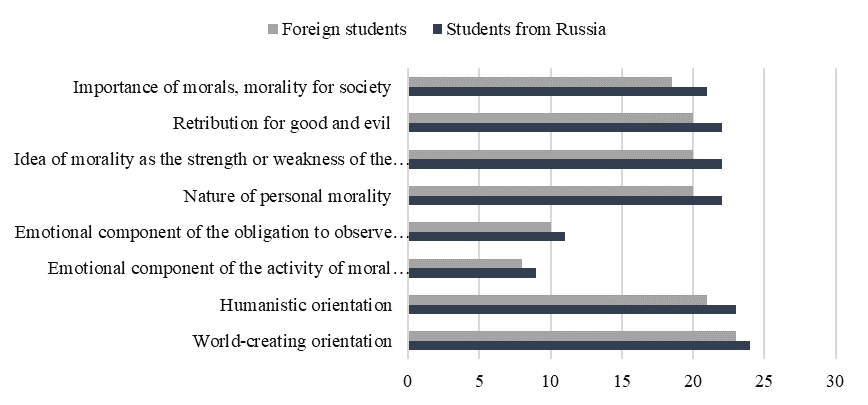

Conclusion
The following conclusions can be drawn from this research which was aimed at studying the influence of socio-demographic and ethno-cultural factors on the formation of morality among modern students.
Socio-demographic factors of the development of morality among modern students
Belonging a particular gender and age group largely determines the characteristics of ideas about morality and morals, moral strategies and moral orientations of students. Young men are more inclined than young women to a strategy of activity of moral behavior at an emotional level. Unlike young men, young women strongly believe that the origin of morality is a natural property of any community; they recognize the high importance of moral principles for society, that moral actions should be rewarded and evil should be punished; they adopt a strategy of obligatory observance of moral norms at an emotional level; they adopt a strategy of activity of moral behavior at a cognitive level, and are more inclined to a humanistic and world-creating orientation.
Belonging to a particular age group has a certain impact on the development of the moral sphere among students. Youth is characterized by a relatively greater significance of concern for the morals for society and the retribution for good and evil and morality as the strength of the personality. They are more inclined to a strategy of obligatory observance of moral norms at the emotional level and to a strategy of activity of moral behavior at the conative level, and to a group-centered, humanistic and world-creating orientation of the individual. For the older age cohort (from 20 to 22 years), a gradual decrease in the significance of the above indicators is characteristic. Therefore, the period of youth (from 17 to 19 years) is a sensitive period for the formation of morality among modern students.
Ethno-cultural factors of moral development among modern students
The ideas about morality and morals, moral strategies and moral orientations of students ' personality are largely determined by their belonging to a specific ethnic group. The Russian students are distinguished by the recognition of the high importance of morality and morals for society, and the awareness of personal responsibility for their moral appearance. For the Tatars, it is characteristic to adopt a strategy of activity in observing moral norms at an emotional level. The Kazakhs are characterized by the presence of internal moral control of the personality. The representatives of the peoples of the Caucasus are sure that there is a retribution for good and evil, that observance of moral norms is a manifestation of the strength of the personality and everyone is responsible for the ethics of their behavior. They are more inclined to a humanistic orientation of the personality. A distinctive characteristic of the Mestizos is the expression of the world-creating orientation of the personality.
A significant differentiating factor is confessional affiliation, which determines the peculiarities of ideas about morality and morals, the moral strategies of the respondents. Students who profess Orthodoxy and Islam are sure that morality has a divine origin, moral norms are absolute, eternal and unchangeable. The Orthodox and the Atheists recognize the high importance of morality and morals for society. The Orthodox are characterized by the belief that the villain will be punished sooner or later, observance of moral norms and principles is an indicator of a strong personality, and the adoption of a strategy of activity in observing the moral norms at an emotional level. The Atheists are more aware of their personal responsibility for their moral appearance.
Belonging to a certain socio-cultural environment is an important factor determining the indicators of modern students ' morality. The students from Russia exhibited greater significance in ideas about morality (the importance of morality for society, the retribution for good and evil, the idea of morality as the strength of the personality, and the nature of personal morality), moral strategies (the emotional component of obligatory observance of moral norms, and the emotional component of the activity of moral behavior) and moral orientations (humanistic, world-creating). The results of the research actualize the need to organize targeted work with foreign students to enable them to adapt to a new socio-cultural environment by getting them acquainted with the culture, history and identity of the peoples of Russia, and by exchanging cultural experiences.
Thus, the initial hypothesis that socio-demographic (gender, age) and ethno-cultural factors (ethnic, confessional and socio-cultural affiliation) determine the peculiarities of ideas about morality and morals, moral strategies and moral orientations of students ' personality, was generally confirmed. Further research can involve the dynamics of moral indicators among students in the process of their professionalization: belonging to a certain educational and professional community, the level (secondary or higher; bachelor's, master's, postgraduate) of professional education, and the form of training (full-time or correspondence).
Acknowledgments
The research was carried out with the financial support of the Russian Foundation for Basic Researches (RFBR) in the framework of scientific project № 20-013-00072 “Personal Factors of Family Self-determination Development in Adolescence and Early Adulthood”.
References
Akimova, M. K., & Galstyan, O. A. (2019). Typology of Youth Social Activity Depending on the Adoption of Moral Standards. Psychological Questions, 3, 51-61.
Cotney, J. L., & Banerjee, R. (2017). Adolescents’ Conceptualizations of Kindness and its Links with Well-being: A Focus Group Study. Jthisnal of Social and Personal Relationships, 36(2), 599-617. https://doi.org/10.1177/0265407517738584
Crocetti, E., Moscatelli, S., Kaniušonytė, G., Meeus, W., Žukauskienė, R., & Rubini, M. (2019). Developing Morality, Competence, and Sociability in Adolescence: A Longitudinal Study of Gender Differences. Jthisnal of Youth and Adolescence, 48, 1009–1021.
Kislyakov, P. A., Shmeleva, E. A., & Aleksandrovich, M. A. (2020). Moral Grounds and Social Norms of Safe Prosocial Behavior of Young People. Education and Science, 22(10), 116-138.
Kupreichenko, A. B., & Vorobiova, A. E. (2013). Moral Self-determination of Youth. Publishing House “Institute of Psychology of the Russian Academy of Sciences”.
Lopatukhina, T. A., & Rynkevich, A. V. (2016). Pedagogical Content Three-factor Model of Educating High-school Students for Professional Activities. Education and Science, 7(136), 56-72. https://doi.org/10.17853/1994–5639–2016–7–56–72
Medvedeva, T. I., Enikolopov, S. N., Vorontsova, O. Yu., & Kazmina, O. Yu. (2019). Gender Differences in Making Moral Decisions. Psychological Questions, 1, 124-133.
Molchanov, S. V., Almazova, O. V., & Poskrebysheva, N. N. (2019). Moral Judgments in Adolescents with Different Levels of Psychological Well-being. Psychological Science and Education, 24(4), 22-35.
Molchanov, S. V., Almazova, O. V., Kirsanov, K. A., & Poskrebisheva, N. N. (2018). Cognitive Processing of Social Information in Internet and Features of Moral Consciousness in Adolescents. Psychological Science and Education, 23(5), 77-86.
Popova, N. V., & Popova, E. V. (2018). Volunteering as a Factor in the Formation of Moral Standards among Young People. Education and Science, 20(10), 139-155.
Potanina, L. T., & Gusev, A. N. (2018). Pragmatic/Non-pragmatic View of the World as an Indicator of Moral Development in School Students. Psychological Questions, 5, 23-32.
Shadrikov, V. D. (2018). Conscience: Psychological and Philosophical Analysis. Psychological Jthisnal, 39(1), 5-14.
Veselova, E. K., & Korzhova, E. Y. (2020). Ethical and Moral Levels in the Functioning of the Personality of the Educational Psychologist. Psychology in Russia: State of the Art, 13(1), 22 -32.
Vorobiova, А. Е. (2013). Moral Self-Determination of Young People of Different Professions. Izvestiya of Saratov University. Educational Acmeology. Developmental Psychology, 5.2(18), 136-143.
Zhuravlev, A. L., & Kupreichenko, A. B. (2007). Economic Self-determination: Theory and Empirical Research. Publishing House “Institute of Psychology of the Russian Academy of Sciences”.
Copyright information

This work is licensed under a Creative Commons Attribution-NonCommercial-NoDerivatives 4.0 International License.
About this article
Publication Date
31 October 2021
Article Doi
eBook ISBN
978-1-80296-953-5
Publisher
European Publisher
Volume
2
Print ISBN (optional)
-
Edition Number
1st Edition
Pages
1-219
Subjects
Education, educational psychology, pedagogy, positive pedagogy, special education, second language teaching
Cite this article as:
Merzlyakova, S. V., Golubeva, M., & Bibarsova, N. (2021). Socio-Demographic and Cultural Determinants of Modern Students’ Morality. In P. Besedová, N. Heinrichová, & J. Ondráková (Eds.), ICEEPSY 2021: Education and Educational Psychology, vol 2. European Proceedings of International Conference on Education and Educational Psychology (pp. 192-203). European Publisher. https://doi.org/10.15405/epiceepsy.21101.18

